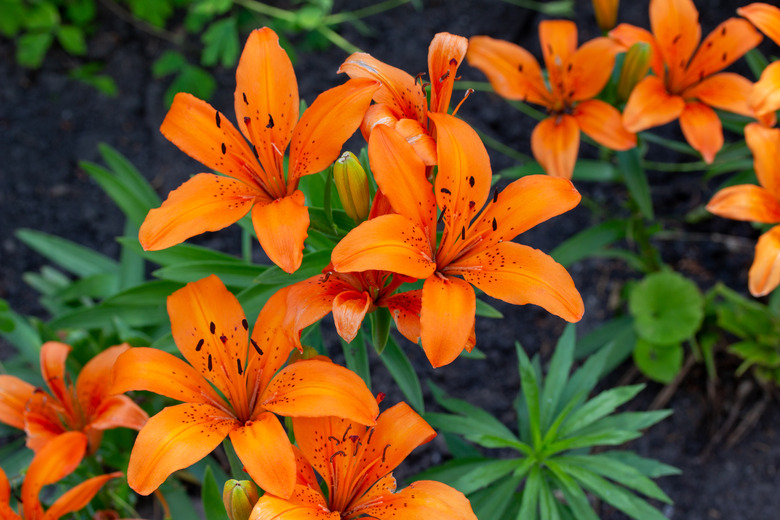Asiatic Lilies & Companion Plants
Asiatic lilies (Lilium x) are low-maintenance perennials that provide graceful blooms and long-lasting cut flowers. They bloom mostly in June and July with flowers that are 4 inches across, according to North Dakota State University. Most Asiatics are hardy in USDA zones 4 through 8. That leaves them standing headless in the garden for another three months in most places until their leaves have done their job and wilt back. Use companion plants to provide a succession of bloom that will complement the Asiatics in your garden.
Asiatic Lily Features
Asiatic lilies are hybrids of various species lilies. They have the widest variety of colors; whites, yellows, oranges, reds, violets and various mixtures. Generally, they are the longest-blooming of all the lilies. Although they do not all bloom at the same time, one variety or another is in bloom over a month of early summer. They grow in brightest sunshine but bloom well in light shade, too. These elegant, undemanding plants are the perfect choice for the beginning perennial gardener.
Asiatic Lily Planting Considerations
Asiatic lilies like their "feet" planted deep. Bulbs planted 4 to 6 inches below the surface pull themselves downward as they grow larger. The North Carolina State University Extension recommends planting these bulbs at a depth of 8 inches. Because they "sit" so deep, a variety of shallow-rooted plants can be interplanted with them.
An ideal spots for where to plant lilies in the garden is a full-sun location with slightly acidic, very well-draining garden soil, which is also just the right environment for most garden perennials. Asiatics grow from 2 to 4 feet tall, rising above many peonies and leaving room for shorter plants to shine.
Companion Asiatic Lily Planting Ideas
Other lilies make good companions if they extend the bloom of Asiatic lilies. Trumpet lilies, also called Aurelian lilies, are hybrid lilies that bloom mid to late summer but are not as cold-hardy as Asiatics. Oriental lilies are the latest bloomers but require partial shade and mulch for cool roots.
Tiger lilies, with recurved and spotted petals, bloom last of most lilies atop stalks that may reach a height of 6 feet. Orienpet lilies, which are crosses of Oriental and trumpet (Aurelian) lilies, are towering garden beauties, often exceeding heights of 6 feet. Because of their height, the bulbs of Orienpet lilies are deeply planted but slightly above Asiatic bulbs. Although all types of lilies are not as cold-hardy as Asiatics, most are hardy to Zone 4 or 5 and, with the appropriate light, coexist easily together.
Shallow-Rooted Asiatic Lily Companion Plants
Most annuals have shallow roots and bloom later than lilies. Annuals also make good companion plants for lilies in pots. Snapdragons, rudbeckia, sweet peas or any annual that likes moist, well-draining, slightly acidic soil will make a good companion.
Peonies, iris and columbine are all shallow-rooted plants that will precede lily blooms. Gladiolus is shallow-rooted and will not overgrow lilies until after they are finished blooming. In warmer zones, cannas or torch lilies can be added as midsummer companions.
Short Asiatic Lily Companion Plants
Daylilies, dahlias, campanula, coreopsis, dianthus and Shasta daisies all make good hardy summer-flowering companions clustered around the tall, leafy lily stalks. Chrysanthemums and asters provide late-season color to finish the succession of bloom and mask lily stalk bases as they begin to brown.
